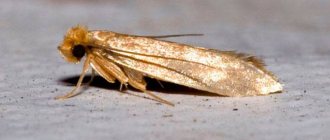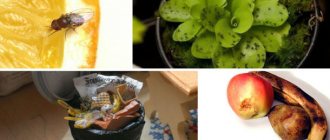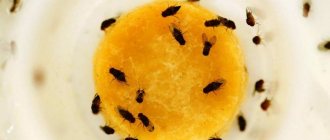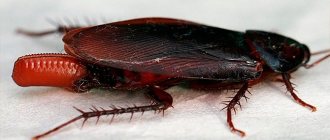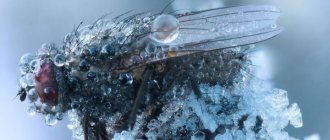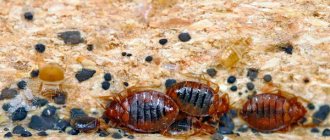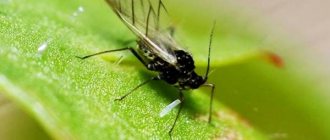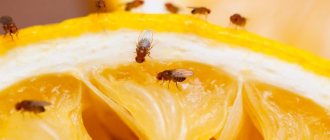Greetings, dear ones! Summer is coming, which means the amount of fruits and vegetables at home will increase significantly! If stored incorrectly or for a long time, some fruits and vegetables begin to rot, we don’t have time to keep track of this and, as an option, nasty black midges appear.
Getting rid of them is not so easy. But I have prepared this article for you, from which you will learn how to get rid of midges in an apartment. Read!
Who among us has not encountered this problem? Midges appear suddenly in an apartment and are very annoying, annoying the residents with their presence. Some species - and there are a lot of them - can even bite. But the good news is that the methods of dealing with them are the same, and you don’t have to read a bunch of literature in order to determine which of their representatives you are fighting with.
Where do small midges come from in an apartment?
The very first thing to do is to establish the cause of the appearance of midges. Only after this can you begin to effectively fight them in the apartment.
Where they can come from is a mystery to many, because outside the window it can be any time of the year. The windows and doors are closed in winter, that is, there is simply nowhere for midges to fly in.
We list the main reasons for the appearance of these unwanted guests in your home:
Biologists say one of the most common reasons for the appearance of midges in an apartment is dirty fruits or vegetables brought home from the garden or store.
Long before they appear on your table, eggs were laid on the fruits, which are in a state of rest, remission, waiting for the fruit to begin to deteriorate and rot.
This is where their finest hour comes, because this is the main food for midges. Larvae emerge from the eggs, which very quickly turn into midges.
Their lifespan is very short, only about a day. But in the presence of an abundant nutrient medium, for example, rotting fruit, they multiply very intensively, which leads to the rapid filling of the room with these insects if measures to eliminate the outbreak were not taken in time.
A very common and widespread reason for the appearance of midges is also insufficient hygiene of the trash can and irregular garbage disposal.
There may be eggs in the leftover food lying in the garbage, and when rotting begins, they begin to wake up.
If the waste gets on the surface of the bucket itself, and is not noticed, this can also serve as the arrival of an army of small parasites.
You should also remember about such a place in the house as a living corner
There is always organic matter with traces of rotting there. For example, an aquarium with abundant algae growth and water that has not been changed for a long time, or a cage with a rabbit or other animal. Such places should always be clean so that insects do not have the opportunity to feed there and lay eggs.
Indoor plants can also cause abundant reproduction of midges
Especially if such a folk method of fertilization as tea leaves is used. Midges are very fond of tea and its remains.
Also, the cause may be high humidity in and around the pots, associated with abundant watering of indoor plants.
Well, the most mysterious place where midges appear, when it seems that everything around is simply licked and perfectly clean, is the water supply and sewage system
Pieces of food falling into the sewer can get stuck in the siphons of sinks and toilets and continue to rot there. This provokes the constant and uncontrollable appearance of midges throughout the house.
From all of the above, we can conclude that midges appear in the house precisely because of problems with the hygiene of the room and its communications.
Midges enter the house only with the help of a person who personally brings them into the house. Their further life and development depends on the cleanliness of the room in which they find themselves.
Mosquitoes
Mosquitoes are a whole family of insects that feed on blood. They can enter your home through open windows and vents, through ventilation or drainage systems and are one of the most common pests in the warm season.
- Mosquitoes have dark gray bodies, up to 1 centimeter in length, and transparent wings located parallel to the body.
- Insects emit a characteristic monotonous squeak during flight, which is easy to hear if the parasite is hovering around your head.
- Mosquito bites are sometimes felt, sometimes not, it all depends on the individual sensitivity of the skin and where your attention is directed - most often, if people are passionate or busy with something, the moment of the bite goes unnoticed.
- The bite itself looks like redness that is dense to the touch, itches, and sometimes there is a small swelling around it, but in most cases it goes away after 1–4 hours.
Mosquitoes breed in water and places with high humidity, so they cannot literally live in your bed, however, it is more convenient for them to feed on your blood precisely while you are sleeping, so bites are often discovered in the morning.
Prevention rules - how to prevent midges from appearing in your apartment in the future?
Preventing the appearance of midges in your home is very simple and clear. This -
Compliance with hygiene rules for residential premises
- Regular cleaning and trash removal.
- Regular cleaning of the trash can.
- Siphon cleaning.
- Timely discarding of food that has begun to spoil.
Also, pungent and persistent odors are good for preventing midges. For example, the smell of garlic or geranium, camphor or incense, if they do not prevent the appearance of midges 100%, will significantly reduce the risk of their appearance.
These measures are guaranteed to rid your home of annoying, uninvited guests.
Source: colady.ru
Reasons for the appearance of midges in the apartment
Where do the midges come from in my apartment? - a question that worries many housewives. To answer it, we will analyze in detail what these flies are, how they reproduce and what they like.
Fruit flies are different - fruit flies do not live long, but it all depends on the living conditions. The cooler the environment, the longer the flies live. Therefore, in winter they live up to three months, and in summer, when the air temperature rises to 25 degrees, they live only 10 days.
Drosophila reproduce very quickly. At one time, flies lay up to 80 eggs.
They prefer fruits and vegetables, sweet juices, syrups and alcohol. Once in the nutrient medium, larvae emerge from their eggs - white worms 3 millimeters long. In a favorable environment, midges appear within 4 days, and after eight hours they are already laying eggs. Therefore, there are always a lot of them in the house, unless measures are taken to destroy them.
There are several features of these insects: Drosophila lay eggs under the skin of ripe fruits, so no matter how much the fruits are washed, the larvae are there.
To get rid of them you need to wash them with soap or pour boiling water over the fruits. They also feel good in sewers, which is why they are confused with sewer flies. Midges appear early in the morning, so it seems to a person that they come out of nowhere.
Drosophila can feed and reproduce on 400 different types of plants. It’s hard to even imagine how much this is. Flies prefer sweet and citrus smells and can even be attracted to the smell of air freshener.
If a fruit fly is deprived of food and habitat, it may fly away. But how long it can fly on its tiny wings remains a mystery. Fruit midges react well to sudden movements and fly away, so if you decide to catch them manually, be patient.
Because no matter how much you catch it, it will still fly away. It will be more effective to use traps. A dry environment is destructive for midges. She loves dampness and mold, and tolerates frost quite well.
Fleas
A person can be bitten by several types of fleas
and all of them are carriers of parasites and various diseases, from helminthiases to plague, borreliosis and various types of typhus.
- The size of fleas living in the Central region of Russia usually varies between 0.5–3 millimeters, so the insects look mostly like dark moving dots.
- A flea bite always feels like a sharp, burning pain at the site of the skin puncture.
- A small, hard, dried drop of blood may remain at the site of the bite.
- Insects are not particularly scrupulous in choosing a place on the body to feed on, so they can bite in any open areas of the skin.
- The flea bite begins to itch instantly and itch severely for several days.
Fleas do not tend to gather en masse to nest in a specific place, so they can live scatteredly anywhere in the house, not necessarily in or near the bed. If you suspect that it is fleas that are biting you, they live throughout the room.
Helpful advice
Lice
provoke the development of pediculosis and can be carriers of typhus and relapsing fever.
- Depending on the type of lice, the length of their light, oblong or round bodies can range from 1 to 4 millimeters.
- Most lice live directly on a person and constantly feed on his blood; body lice can live in things or a room, but not very far from the food source - a person.
- Lice bites are not felt, but after some time, which depends on the individual characteristics of the body, they begin to itch.
- If there are a large number of pests, their bites may merge into single red spots on the skin and become covered with a white flaky crust.
If you suspect that there are lice at home, you should start looking for them not from the bed or room, but from your own body. Insects can live on the head, eyebrows, mustache, armpits, groin, any place where hair is longer than 2-3 millimeters. Body lice can also be found on fleecy fabrics, which are similar in structure to hair.
Causes of midges
Where do midges come from in an apartment? There are quite a few reasons for their appearance. The main ones are described below: Midges appear in the house if you do not sort out fruits and vegetables in time; rotten fruits are a good environment for their habitat and reproduction.
Dishcloths, floor rags and towels need to be washed frequently because dirt and moisture favor their proliferation. Sinks at home should be cleaned of food debris after each dishwashing, as decaying organic matter contributes to their appearance.
Leaking pipes are a favorable environment for fruit flies, as they love dampness and mold. Therefore, even a small leak can provoke the appearance of a whole horde of nasty midges. Bottles of wine and various syrups should be kept tightly closed, because fruit flies love sweets.
The reason for their appearance may be that the trash can is not taken out. The result will be a horde of annoying midges in your home. Many people wonder why they appear, despite the cleanliness of the apartment. No matter how much you clean, they can fly in from the street or through the ventilation.
Therefore, it is necessary to take care of mosquito nets on windows and ventilation ceilings. Midges can appear not only in the kitchen, but also in the bathroom or toilet. A wet rug or poorly washed bath will suffice.
Pots with indoor flowers are also a favorable habitat for annoying midges if there is constant humidity there. To avoid their appearance, you should cover the ground around the plant with decorative stones or granite chips.
Source: hozuyut.ru
Cockroaches
Cockroaches may begin to bite if their population in the house lacks other food or it is out of reach, or if they have already become accustomed to feeding on human and animal tissue elsewhere and then crawled to you. In practice, this rarely happens yet, but you cannot completely exclude the possibility that it is cockroaches that bite you in bed.
- The sizes depend on the type of cockroaches
, their gender and stage of development; they can be from 1.5 to 6 centimeters in length, on average about 2.5–4 centimeters. - The color can be red, black, brown, copper or brown.
- When a cockroach bites, it tries to tear off a piece of skin from you, so the marks of these attempts look like superficial, ragged abrasions of any shape.
- Sometimes a cockroach does not have enough strength to tear off that piece of skin that it has coveted, then a piece of it remains next to the wound and gradually dries out.
- If you have sensitive skin, dark spots similar to bruises may occur at the site of the bites.
If your bites fit the description of cockroach bites, carefully inspect the entire room where you sleep, as well as the kitchen and bathroom. If you have cockroaches, you are likely to find them when examining them in dark and damp areas of the apartment.
Recommended Links
How to get rid of small midges in an apartment
Unfortunately, even the most meticulous housewives can become victims of hordes of annoying midges.
It is important to understand that these creatures are not as harmless as you might initially think: such proximity can even lead to allergies.
If you discover that midges have appeared in your apartment, you shouldn’t delay eliminating them: that’s why you need to figure out how to deal with them in advance.
Reasons for appearance
First, it is imperative to find out the reason for the appearance of midges in your home. So, where do midges come from in an apartment?
In fact, there can be quite a few reasons for the appearance of these unwanted guests, especially in the warm season: spoiled vegetables and fruits, garbage not thrown out in a timely manner, food debris accumulated in drainpipes, dirty feeders or animal toilets, stagnant water in the aquarium or in flowers.
If you are confident in the impeccability of your cleaning, do not exclude the possibility of a “raid” of midges from your neighbors. So, let’s draw conclusions and get started on how to get rid of small midges in an apartment.
How to fight
The good news is that midges can be defeated using simple mechanical methods and folk tricks. You don’t need to spray toxic insecticides around the house and you don’t have to remember about the well-deserved insect fighter - dichlorvos: The easiest and most accessible way to fight insects, no matter how funny it may sound, is a vacuum cleaner.
Carefully walk with it through places where pests accumulate and, having mercilessly sucked them in with the device, empty the dust collector away from the house.
If small midges in your apartment have infested indoor plants, you need to insert several matches into the pot with the sulfur head down, and also stop fertilizing the flowers with tea.
It is also recommended to spray the plant with a weak solution of potassium permanganate. Making midge traps is an effective control method. For example, you can make a funnel from a plastic bottle or use a yogurt cup, at the bottom of which put a piece of spoiled fruit, a drop of jam or honey.
After collecting the “catch”, dispose of the vessel. An alternative to sweet bait can be a small amount of alcohol. You can use ready-made traps - sticky tapes, placing them closer to the places where midges swarm.
If the place where midges appear is your bathroom, then the best and easiest way is to pour jam syrup into the bathtub. As soon as the midges flock to the sweets, quickly wash them off with a hot shower. Then don’t forget to clean the bathtub, wipe the floor dry and pour boiling water over all the drain holes.
Prevention
To avoid stepping on a rake again, it is recommended to follow a number of preventive measures. First, place mosquito nets on the windows, thereby limiting the possibility of midges entering from the street.
Secondly, do not forget to throw out garbage in a timely manner and sort through fruits/vegetables, sift cereals and flour. You can protect yourself from these parasites in the kitchen by placing walnut leaves or lavender-scented tablets in your cabinets.
Thirdly, wash the aquarium and animal food plates more often. Don’t forget to change the litter in your little brothers’ toilets on time and keep their bedding clean.
Fourthly, do wet cleaning in the apartment more often. This is especially true for hard-to-reach places: under the refrigerator, behind the stove, between tables.
Fifthly, make sure your plumbing is in good working order to avoid unwanted moisture stagnation.
Source: beyklopov.ru
Bites
Those who are faced with the appearance of midges in their apartment wonder whether midges bite. It does not dig in with its sting, but tears out pieces of skin, even microscopic ones. The midge is smaller in size than a mosquito, but bites much more painfully. The insect's saliva gets into the resulting wound and causes an allergy. It can manifest itself in various ways:
- Redness of the skin at the site of the bite;
- A small wound in the middle of a reddened area of skin over a large area;
- Burning and pain;
- Swelling of the tissue and itching in it;
- Various types of rashes;
- When scratching, the wounds may become covered with a black scab;
- With multiple midge bites, body temperature may increase;
- Heartbeat quickens;
- Lymph nodes are enlarged;
- The pressure drops.
Midge bites
Interesting! Midges do not bite at night when a person is sleeping in bed - they are active only during the day. That is why the bed and bedding are not of interest to this insect - while destroying the parasite, you can think about treating the bedroom.
Patients of allergists who came with complaints about biting insects and wondered why midges bite, because they do not eat meat. The fact is that many of these creatures are blood-sucking. By making a hole in the skin, midges feed on the droplets of blood that appear.
Fighting onion midge: best methods
Midges are small flying insects with two wings that happily settle in human homes and feed on plant foods.
In fact, the onion midge consumes not only onions, but also settles on other fruits, berries, and vegetables that are not stored properly in the apartment. There are several species of midges that live on plant products, and most often these are Drosophila (fruit flies) and soil flies.
You should not think that, apart from aesthetic harm, such small insects do not interfere with humans in any way. Even small midges are carriers of diseases. In people prone to allergies, their bites can cause severe skin reactions and swelling.
These insects lay their eggs on food, the larvae emerge from them and immediately begin to feed intensively. Midges stain furniture, walls, and can even fly into a person’s mouth and nose.
Here are the main signs of midges that most often settle at home:
- Size – 1-3 mm
- Oval body
- Slow flight, not like a regular fly
- Six legs, two wings
- Yellowish, brown, black body color
ATTENTION: Whatever species the onion midge belongs to, in a very short period of time its colony will become numerous, because these pests reproduce extremely quickly.
Hives
The harmless urticaria butterfly has nothing to do with it; we are talking about one of the types of dermatitis, whose manifestations are easily confused with insect bites. Urticaria is characterized by red, itchy blisters that resemble nettle burns, which is where it gets its name. Most often, the disease is of an allergic nature, but blisters can appear without an obvious reason one at a time, several at a time, or en masse at once.
The main difference that allows us to distinguish this form of dermatosis from insect bites is that urticaria leaves blisters with a uniform surface; there is no visible point where the bite was made. It may be difficult to see with the naked eye, but a magnifying glass and phone camera can help you enlarge the blisters to the required size and thus more accurately determine their origin.
Carefully!
Where do midges come from?
Despite their small size, insects can fly considerable distances, so they can end up in any apartment. They get to new housing in different ways, here are the main ones:
- Insect eggs may be present on vegetable and fruit products that were bought in a store, at the market, brought from a dacha, or taken from friends.
- It is possible that one or a couple of individuals accidentally enter through a window or door, after which they lay eggs and “start” the reproduction process.
- Pests also enter through ventilation from neighbors.
- To reproduce, insects need a nutrient medium - warm, rotting foods, spilled juices, pieces of plant food lying around, used tea bags, sewerage with an abundance of plaque. Female small flies can also lay eggs on the bedding and food of pets, for example, when their cages are rarely cleaned. Midges love wet, unwashed kitchen rags and napkins.
Midges from onions breed especially well, because if stored improperly, this vegetable begins to rot quickly. Many housewives have onions in a dark, warm place, wrapped in a plastic bag, and this is an ideal condition for them to rot.
Therefore, midges on onions multiply at tremendous speed, and will soon fly throughout the kitchen in dozens and hundreds.
What to do if you find onion midges?
How to get rid of onion midges is a paramount question, and you need to start solving it by finding a place for their active reproduction. The main thing is to leave pests without food and a breeding ground for their offspring. The procedure will be as follows:
- Throw away spoiled onions, carefully sorting through all available vegetables.
- Place the onions in the refrigerator without signs of rotting or spoilage, placing them in small portions in plastic bags.
- If it is not possible to put onions and other root vegetables in the cold, they should be stored in boxes with sawdust, or, as a last resort, in well-ventilated fabric bags.
- Remove all fruits, especially citrus fruits, out of reach of midges.
- Throw out garbage on time, at first - 1-2 times a day.
- Wash dirty dishes immediately after eating.
- Limit the access of insects to water - they also need it for life. To do this, you should close all taps so that they do not drip, leave sinks dry, do not store water on the table, and thoroughly dry clean dishes.
- Remove and clean siphons a couple of times a week and use disinfectants to clean the sewer system.
- Wash your pets' cages regularly and prevent food residues from being left there.
IMPORTANT: If there are plants in the apartment, they also need to be cleaned, because insects can settle on them for lack of other food. You should reduce the frequency of watering and stop pouring tea leaves on the ground. If necessary, you can spray the flowers with a weak solution of potassium permanganate.
Life cycle and reproduction
An adult moth lives about 60-70 hours. During this time, the female is able to lay eggs 2-3 times. The best environment for their development is poplar fluff, last year's foliage, quiet dry corners in residential and non-residential premises. Within 7-10 days, larvae about 5 mm long will form from the eggs. They penetrate the leaf plate and cover the entrance with a special shell.
Thanks to increased feeding on green leaves, the larvae grow quickly. During the first two stages they do not have legs.
Each larval stage ends with a molt. At the third and fourth stages of development, the larvae change color from light yellow to orange. During the same period, they develop abdominal and thoracic legs, and the larva turns into a caterpillar.
After 8-9 days, the caterpillar again changes color to a shiny brown. Her abdominal region takes on a pointed shape - the first sign of the onset of pupation. At this time, the body length of the caterpillars is about 4 cm.
After a week or a week and a half, a butterfly emerges from a fully formed cocoon. This happens at the end of July or August: the mass emergence of butterflies occurs over the course of a month and a half. At the beginning of September, butterflies leave for the winter.
In the spring, as soon as warm days arrive, butterflies move from their shelters to tree trunks. Then the development cycle repeats again.
How to make midge traps?
Onion midges sometimes multiply on such a scale that simply getting rid of rotting vegetables does not bring proper and quick results. In this case, the hostess will have to take a number of more radical measures to get rid of uninvited guests. How to make baits with your own hands where insects will die? Here are good ways:
- Take a 0.5 liter plastic disposable glass, throw a piece of fruit into the bottom or pour a little sweet juice (compote). Wrap the glass in cling film, making several small holes in it. Leave the trap in the kitchen overnight, quickly put the glass in a tight bag in the morning and take it out of the house.
- Pour juice into the bottom of the jar or put overripe fruit, cut into slices. Cover the top of the jar with a paper funnel, placing its narrow side inward. Leave the jar on the table at night, pour water into it in the morning - all the midges will die.
- Pour water into a flat plate, drop a little citrus-scented dishwashing detergent into the water. The insects will land on the water, but will no longer be able to take off.
You can also get rid of flies using medications. Nowadays, any store sells special adhesive tapes and sheets to which harmful insects quickly stick. It is not recommended to use aerosols and other chemicals, because their residues can end up on the table or in food, causing harm to humans.
But ventilating the apartment and mechanically removing pests using a towel through the window, or sucking them up with a vacuum cleaner will definitely not do any harm and are perfect as one of a set of measures to combat midges.
Habitat, lifestyle and nutrition
In nature, the moth lives in those areas where balsam, fragrant, pyramidal poplars grow:
- in the European part of Russia;
- on the territory of the Caucasus;
- in the Central Asian region.
Adults do not feed. They live off what they have stored while in the caterpillar stage. But the larvae are distinguished by their extraordinary gluttony. They eat young leaves:
- drain;
- pears;
- apple trees;
- poplars and other trees.
Just one larva can gnaw a hole with a diameter of about 2 cm in a leaf. If there are many pests, the trees may be left without foliage as early as July-August.
Pest
Penetrating into a person’s home, butterflies settle in chandeliers, lampshades, electrical appliances, containers with bulk products, and dried fruits. They also love various secluded places - behind furniture, radiators, etc.
How to prevent the reappearance of pests?
To prevent insects from settling in your house or apartment again, you need to take measures to repel them. Thus, onion midges cannot tolerate the smell of pine needles and basil. Therefore, you need to purchase essential oils of fir, pine, and basil, soak cotton wool in them and place them in places where vegetables are stored.
Insects do not like the smell of clove seasoning - it can be stuck into citrus fruits that are stored outside the refrigerator. Midges also react negatively to the aromas of ylang-ylang, patchouli, and verbena oils, so they can be dripped into aroma lamps and used regularly.
Midges also cannot stand the smell of camphor, which, by the way, is absolutely not harmful to humans. Preventing the appearance of midges is not difficult, but it is effective, and an unpleasant neighborhood will most likely not happen to them.
Source: gdeklop.ru
Blood-sucking bugs
Blood-sucking bedbugs are the only insects listed here that literally live in beds, sofas, bedding, and the folds of mattresses and pillows.
- The size of bedbugs most often varies between 5–7 millimeters, the bodies of females are rounded, those of males are more elongated, the color is brown, copper, or reddish-brown.
- The larvae look like smaller versions of adult bedbugs, but are lighter in color and smaller in size.
- Bed bugs leave behind a brown, corrosive dirt that is easy to find in places where insects accumulate.
- Bite marks look like swollen red dots, which always appear in several pieces and line up in a chain.
- When bugs puncture the skin, they inject an anesthetic into it, so the moment of the bite may not be felt; in larvae, this body system is underdeveloped, so their bites, on the contrary, can be painful.
